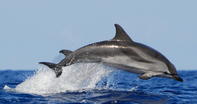
Name : Striped Dolphin Scientific Name : Stenella coeruleoalba
Class : Mammalia
Family : Delphinidae
Order : Cetacea (suborder) - Odontoceti
Shape : The adult's body is slender and fusiform. The snout is distinct from the head and long and thin. There are 45 to 50 small cone-shaped teeth on each side of the upper jaw and 43 to 49 on each side of the lower jaw.
Fins : The dorsal fin is median, falcate, and medium-sized. The pectoral fins are short. The flukes show a pronounced notch.
Length : Measures vary according to different geographic populations. Adults measure between 2 - 2.50 metres and newborns in the range of 90 cm - 1 metre.
Weight : Its average weight varies from 110 - 140 kg.
Colour : The back is dark grey to brown or a bluish-grey, the flanks are lighter-colored, and the stomach is white. The eyes are circled in black. Two black stripes start from the eyes, one (which may be double) going to the anal area and the other (which may also be double) running to the pectorals. There is a dark falcate area under the dorsal fin, the point of which is directed towards the dolphin's front, with the base of this stain remaining on the dark colouring of the back. The dorsal fin, the pectoral fins, the flukes, the upper jaw, and half the lower jaw are dark.
Diet : It consumes shrimp and octopus, but only in small quantities. It feeds mostly on mesopelagic fish and in the
Mediterranean, it feeds primarily on sardines and anchovies.
Population : This species is quite common in the areas it frequents, except for the western Pacific. It has been noticed that in the western Mediterranean it has started occupying the biotope of the common dolphin, which appears to be disappearing from this region.
Migration : It may move seasonally with warm oceanic currents in some areas.
Habits : The Striped Dolphin often jumps acrobatically out of the water. It swims in bands of 10 to 20 individuals, or sometimes groups of many hundreds.
Distribution : This dolphin is found in temperate, tropical, and subtropical waters around the world. It prefers deep water and remains rare in coastal areas.